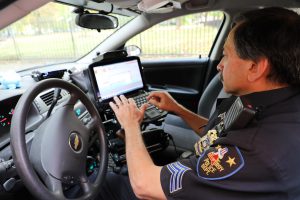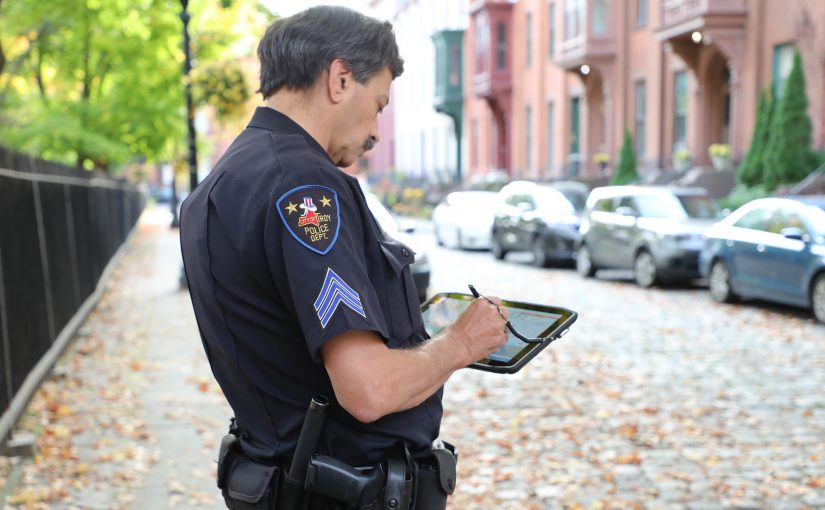When the City of Troy, New York, Police Department planned to upgrade its two-way radio system in 2015, Community Police Sergeant Sam Carello and the department leadership figured it was a good time to evaluate all the department’s patrol car technology. They surmised that new enterprise technology would offer greater workflow efficiency than the mobile data terminals (MDTs) the Troy Police Department had installed in its cars starting in the 1980s.
As it turned out, the Troy Police Department patrol officers used the MDTs only for the purpose of accessing license plate and driver’s license data through the New York State TraCS ticketing system during traffic stops. To determine the urgency of police dispatch calls, officers had to use their two-way radios and personal cellphones.
“From day one, not every car had one, they didn’t always work correctly, and they took up a lot of room— you really couldn’t have two-person units in the cars that had them,” Carello said of the MDTs, which were permanently mounted in the cars designated for traffic law enforcement.
By 2015, the Troy Police Department sought to equip officers with access to real-time, in-progress call data without exclusively relying on their radios. To do that, it needed to integrate its patrol car technology with Rensselaer County’s public safety call dispatching system. Carello knew that adopting more compact and portable devices also would give the Troy Police Department the potential for a more mobile future police force.
Small Size and Fast Data Processing
The answer emerged when Carello and fellow Troy PD leadership visited the 2015 International Wireless Communications Expo: the Xplore XSLATE R12 Rugged Tablet PC, one of the fastest rugged tablets available. Zebra acquired Xplore Technologies in 2018 and continues to offer the XSLATE R12. “We were astounded by how small they were and their capability,” he says of the devices, which measure 12.93 inches by 8.17 inches and 0.75 inch thick.
The Troy Police Department gradually equipped its patrol cars with the XSLATE R12s . By 2019, the department was in a position to increase the number of cars with tablets to 29. On every shift, the Troy Police Department schedules at least one desk sergeant, one road sergeant, and eight patrol officers, the latter group in XSLATE R12-equipped cars.
Instant Call-in-Progress Information
Looking back at a career that began in 1979, Carello has a perspective on how devices built for the demands of police work can enable digitization, transforming officers’ workflows that previously centered around the two-way radio.
Digitization arguably transforms the work of a road sergeant on duty more than that of any other officer. When Carello started his career, the sole communication tool available was the portable radio. Back then, the dispatcher, not the road sergeant, essentially prioritized the calls and held them when not enough information was immediately available to determine if some calls were emergencies or if they involved police-related issues at all.
Since 2015, the XSLATE R12s, running TriTech/CentralSquare’s Computer-Aided Dispatch software program, have given the road sergeant more immediate visibility of call information for purposes of prioritizing and assigning units accordingly. A Troy Police Department officer now makes these law enforcement decisions.
“Now, what happens is, the road sergeant can look at his screen and see what calls are being held and he can make decisions that the dispatchers can’t—that’s the biggest thing,” Carello says. When four or five officers are at a scene, the road sergeant can hold routine calls such as parking violations and refer to the call list on the XSlate R12’s screen to start prioritizing calls in progress and reallocate manpower across the city.
Empowering Officers, Keeping Airways Open
In some cases, the Troy Police Department can empower patrol officers to self-assign routine calls as part of its new XSLATE R12-enabled workflows.
When an emergency call warrants it, the Troy Police Department puts into effect a “priority air” protocol in which radio traffic is reserved for only those officers assigned to the call. Patrol officers who aren’t assigned to the emergency call can self-assign more routine calls. “They can arrive on a scene, handle the call and give a disposition—all through the tablet without going over the radio at all. That’s really a godsend for us,” Carello says.
When the road sergeant has been outside of the car for some time and the dispatcher informs him of a call in progress, he can get details more quickly than before. “The information is right there in front of you, and you can make those decisions instantaneously,” he says.
Rugged Enough for Police Work

Mobile patrol car technology needs to be rugged enough to withstand the rigors of police work, and the XSLATE R12 has shown Carello it’s up to the task. “I’ve been in the car during some high-speed chases and the tablet gets bounced around,” he says. “It hasn’t failed me yet.” On those occasions when a patrol car gets in an accident and is totaled, switching the tablet to another car is easier than attempting the same with the old MDTs, he adds.
Easier Information Verification
As in any other kind of work, in police work, the written word is a much more reliable form of communication for purposes of information verification than verbal interactions are. In instances of car chases that begin in a neighboring police jurisdiction and continue into the Troy Police Department’s jurisdiction, it’s more likely for an inaccurate transcription of a license plate number to occur over the two-way radio than via the tablets, Carello points out. “Especially if a call had to go through a couple agencies, something was always lost in translation,” he says. “I don’t think that’s happening as much as it used to.”
More Efficient Report Writing
The XSLATE R12s are part of a fairly common, yet valuable, paper-to-pixels transformation not unique to police work: the elimination of handwritten reports. Officers can write their crash reports and traffic citations on the XSLATE R12s and can print them at the headquarters or on the spot. Soon after scaling its implementation of the tablets in 2019, the Troy Police Department planned to use Tritech/CentralSquare’s Computer Aided Dispatch report and records management solution for computerized police report writing.
“Not only can they knock out a report, they can have an accident description and a diagram already drawn in and issue tickets in about 15 minutes,” Carello says of crash report writing. “In the old days, where you did everything by hand, it probably took you 20 minutes just to do the crash report alone, then you had to hand-draw a diagram to match the accident, and then you had to handwrite the tickets. With the tablet, the way we have it all set up to integrate with the New York State TraCS ticketing system, we can print them out in just a few minutes—it’s so much quicker and easier.”
A Mobility-Powered Law Enforcement Future
After the Troy Police Department’s 2019 XSLATE R12 purchase, Carello looked toward some new uses that take greater advantage of its mobile capabilities. Officers can detach the rugged tablets and utilize them on the front lines of police work, such as taking witness testimony or photos at crime scenes for report dispositions.
Additionally, “Say we’ve got a traffic safety checkpoint. That tablet can come out and run off the battery and you can run a license or registration check right away—it’s instantaneous,” he says. “You’re so much more efficient even when you’re writing a ticket. You’re not detaining that person for a long time. In the old days, when you stopped somebody, you had to call it in on the radio and run the license number on the teletype system and wait for the reply. Then dispatch had to get back to you on the radio and you had to scribble down the license information on a piece of scrap paper or write it on a ticket. Now, you can just scan everything in, run the plate yourself and the information shows up on the screen.”
“We’ve come from a place where there was very little technology here to this point and it’s astounding how far we’ve come,” Carello says. “The tablets give us an opportunity to be more proactive than we’ve been. The ability to get information out to all the cars all at once is just phenomenal.”



